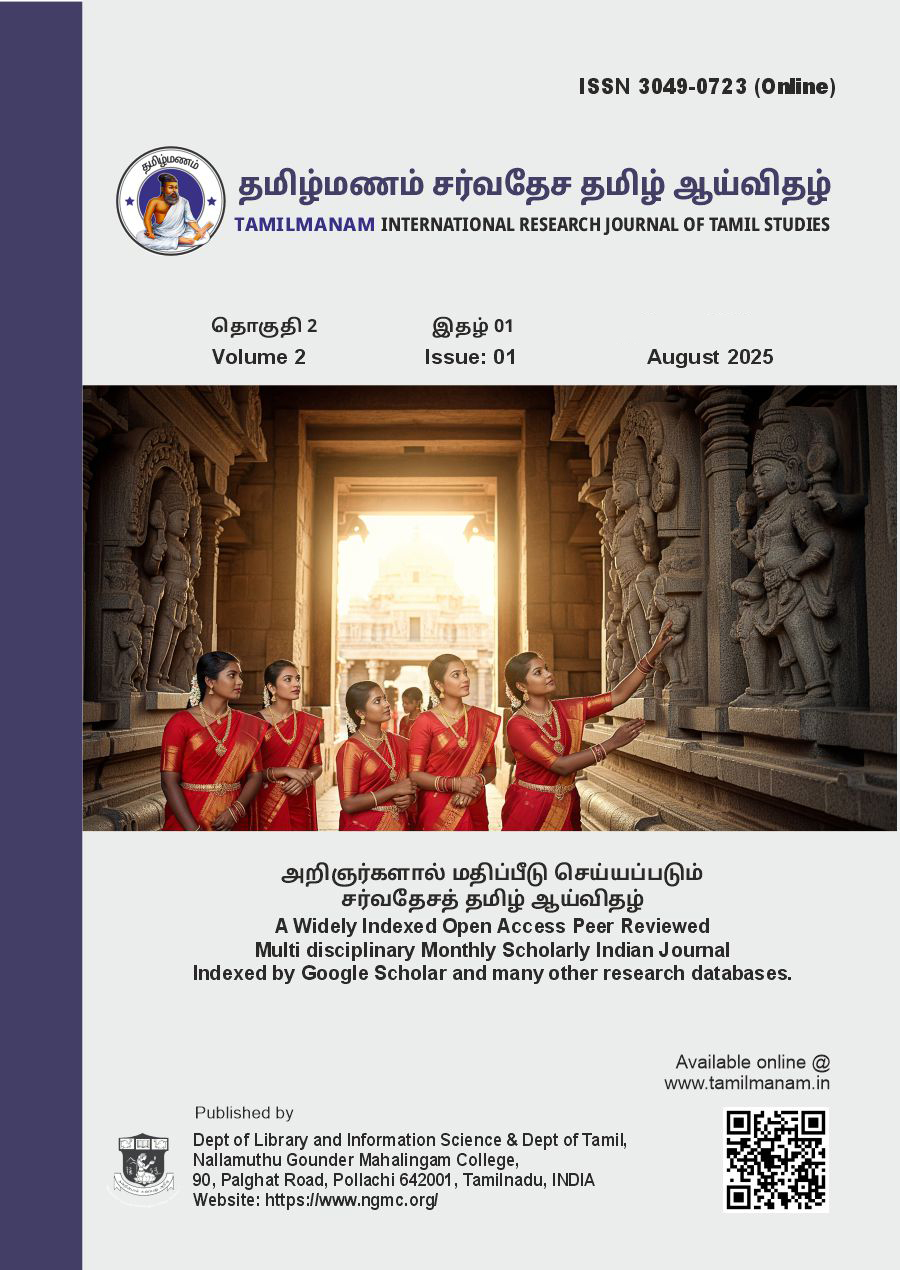திணைவழியே தலைவியின் உணர்ச்சி பதிவுகள்
Emotional Records of the Heroine Through Thinaisal
DOI:
https://doi.org/10.63300/tm0110012511Keywords:
திணை, சங்க இலக்கியம், உணர்ச்சி, தலைவி, தலைவன், பண்பு, களவு, கற்பு, பசலை நோய், நிறக்குறியீடுAbstract
This article primarily investigates how the heroine's emotions are revealed through the Thinai (landscape-based poetic genre) in Sangam literature. In the Sangam period, emotion was considered an integral part of human life, intertwined with nature, as a component of one's mental state. The heroine's physical and psychological emotions, such as the hero's separation, secret love (kallavolukkam), love-sickness (pasalai noi), pangs of love, mental depression, and helplessness, are expressed through color symbolism, statements conveyed via her female companion (Thozhi), and external scenes. Specifically, in Akam (love) poems like Kuruntokai and Narrinai, the heroine's inner feelings gain intricate literary form. Two major emotional states—separation and union—are created through imagery, evidenced by instances such as the onset of pasalai (paleness due to love-sickness), shedding tears, and becoming pale and despondent. These emotions are expressed simply yet intensely through the companion's narrations, humor, symbolism, external imagery, traditional phrases, and Thinai-specific descriptions. By meticulously examining the heroine's emotions from a sociological and psychological perspective, this study illuminates the expression of feminism in Sangam literature and the contemplation of women's status in society. Thus, Sangam literary poems that express the heroine's emotions through Thinai serve as multifaceted documents of emotional identity. In Sangam literature, emotions such as the heroine's sleeplessness, the agony of separation, mental anxiety, loneliness, psychological helplessness, and sorrow are expressed with great subtlety and emphasis through the Thinai structure. Akam literary works like Kuruntokai, Narrinai, and Akananuru notably record how the heroine's restless sleeplessness due to thoughts of the hero is seen as an expression of mental stress and a psychological problem. Based on Freud and other psychological theories, these states are interpreted as psycho-emotional phenomena such as erotomania (love sickness), hysteria, and lack of fulfillment/union. The heroine's sleeplessness, her expressions of sorrow to her companion, and the reflection of her mental distress in natural phenomena describe the psychological nature of a woman. These emotions, intertwined with social, psychological, and cultural contexts, convey the heroine's compassion, frustration, the pain of separation, and the depth of her love. Therefore, the objective of this paper, "Emotional Records of the Heroine Through Thinaisal," is to re-examine and highlight how the background of the heroine's sleeplessness profoundly reflects a person's psychological distress in Sangam literature.
சங்க இலக்கியங்களில், தலைவியின் உணர்வுகள் எவ்வாறு திணை வழியாக வெளிப்படுகின்றன என்பது இக்கட்டுரையின் முக்கிய ஆய்வுப்பார்வையாக உள்ளது. உணர்ச்சி என்பது மனநிலையின் ஒரு கூறாக இயற்கையோடு பிணைந்த மானுட வாழ்வின் அங்கமாக சங்க காலத்தில் கருதப்பட்டது. தலைவன் பிரிந்த நிலையிலும், களவொழுக்கம், பசலை நோய், காம வேதனை, மனச்சோர்வு, ஆற்றாமை போன்ற தலைவியின் உடல் மற்றும் உள உணர்வுகள் நிறக் குறியீடுகள், தோழி வழிக் கூற்றுகள், புறநிலைக் காட்சிகள் ஆகியவற்றின் மூலம் வெளிப்படுகின்றன. குறிப்பாக குறுந்தொகை, நற்றிணை போன்ற அகப்பாடல்களில் தலைவியின் உள்ளுணர்வுகள் மிக நுணுக்கமாக இலக்கிய வடிவம் பெறுகின்றன. பிரிவு மற்றும் புணர்ச்சி ஆகிய இரண்டு முக்கிய மனநிலைகள் பசலை பாய்தல், நீர்வாரல், பசந்து பனிவாகுதல் போன்ற சான்றுகளால் படிமங்கள் மூலம் படைக்கப்படுகின்றன. இந்த உணர்வுகள் தோழி வழிக் கூறல்கள், நகைச்சுவை, குறியீடுகள், புறநிலை வழிப் பிம்பங்கள், மரபுச் சொற்கள், திணைவழிக் கூறல்கள் மூலம் எளிமையாகவும் தீவிரமாகவும் வெளிப்படுகின்றன. தலைவியின் உணர்வுகள் சமூகவியல் மற்றும் உளவியல் பார்வையில் நுணுக்கமாக ஆராயப்படுவதன் மூலம் சங்க இலக்கியங்களில் பெண்ணியத்தின் வெளிப்பாடும், சமூகத்தில் பெண்ணின் நிலை குறித்த சிந்தனையும் விளங்குகிறது. இவ்வாறு திணை வழி தலைவியின் உணர்ச்சிகளை வெளிப்படுத்தும் சங்க இலக்கியப் பாடல்கள், பன்முகத்தன்மை வாய்ந்த ஒரு உணர்ச்சி அடையாள ஆவணங்களாக அமைகின்றன. சங்க இலக்கியங்களில், தலைவியின் உறக்கமின்மை, பிரிவின் வேதனை, மனக்கவலை, தனிமை, உளவியல் ஆற்றாமை, வருத்தம் ஆகிய உணர்ச்சிகள் மிக நுணுக்கமாகவும் அழுத்தமாகவும் திணை அமைப்பின் வாயிலாக வெளிப்படுகின்றன. தலைவனை நினைத்து தலைவி உறக்கமின்றி தவிப்பதும், அந்த நிலை மனஅழுத்தத்தின் வெளிப்பாடாகவும், உளவியல் சிக்கலாகவும் காணப்படுவதையும் குறுந்தொகை, நற்றிணை, அகநானூறு போன்ற அக இலக்கியங்கள் சிறப்பாக பதிவு செய்கின்றன. ஃப்ராய்ட் மற்றும் பிற உளவியல் கோட்பாடுகளின் அடிப்படையில், இந்நிலைகள் காமநோய், மனவலிப்பு, புணர்ச்சி பற்றாக்குறை ஆகிய மன உளவியல் நிகழ்வுகளாக விளக்கப்படுகின்றன. தலைவியின் உறக்கமின்மை, தோழியிடம் கூறும் வருத்தக் கூற்று, இயற்கை நிகழ்வுகளின் மேல் அவளுடைய மன உளைச்சல் பிரதிபலிப்பது போன்றவை, ஒரு பெண்ணின் உளவியல் தன்மையை விவரிக்கின்றன. இந்த உணர்வுகள் சமூக, உளவியல், பண்பாட்டு நிலைகளோடு இணைந்து தலைவியின் மனவுருக்கம், விரக்தி, பிரிவின் வலி, அன்பின் ஆழம் ஆகியவற்றை உணர்த்துகின்றன. எனவே, தலைவியின் உறக்கமின்மையின் பின்னணி ஒருமனிதனின் உளவியல் துயரத்தின் வெளிப்பாடாக சங்க இலக்கியங்களில் அழுத்தமாக விளங்குகிறன என்பதை “திணைவழியே தலைவியின் உணர்ச்சி பதிவுகள்” மீட்டுக்காட்ட எடுத்தாய்வது இக்கட்டுரையின் நோக்கமாகும்.
Downloads
References
1. நாகராசன்.வி, குறுந்தொகை, நியூசெஞ்சுரி புத்தக நிலையம், சென்னை, 2004
2. நாகராசன்.வி, அகநானூறு, நியூசெஞ்சுரி புத்தக நிலையம், சென்னை, 2004
3. தமிழிணையம், திருக்குறள் பரிமேலழகர் உரை, நுண்பொருள் மாலை.
4. தமிழிணையம், நற்றிணை, நியூசெஞ்சுரி பிரிண்டர்ஸ் சென்னை-606098
5. தமிழிணையம், ஐங்குறுநூறு, அண்ணாமலைப் பல்கலைக் கழகத்தாரால் வெளியிடப்பட்டது-1957.
6. வ.சுப.மாணிக்கம், தமிழ்க்காதல்
7. இந்தியப் பல்கலைகழகத் தமிழாசிரியர் மன்றம், ஆய்வுக்கோவை, 2012.
8. க.பஞ்சாங்கம், புனைவுகயளும் உண்மைகளும் திறனாய்வுக் கட்டுரைகள்.
9. நா.சுப்பிரமணியன், சங்க இலக்கிய வாழ்வியல் மற்றும் சூழலியியல், குறிஞ்சிப் பதிப்பகம், 2004.
10. சிற்றேடு, காலாண்டிதழ் ஜனவரி, மார்ச் 2013.
11. Jeyabal.R, (2004) Agananuru, New Century Book house, Chennai.
12. செ. லிட்டின் ப்ளவர், 2021, காதாநாயகி பெண் மன உளவியல், சர்வதேசத் தமிழ் ஆய்விதழ்.
13. தி.கு.இரவிச்சந்திரன், சிக்மண்ட் ப்ராய்ட் உளப்பகுப்பாய்வு அறிவியல், ப.226
14. Sudhir Kakar, The Inner World, P.55
15. S.Freud, Mourning And Melancholia, P.F.L, VOL.11, P.252.
16. S.Freud, Beyond The Pleasure Principle, P.F.L, VOL.11, P.279.
17. சி.நாகமணி, குறுந்தொகை ஓர் உளப்பகுப்பாய்வு அணுகுமுறை, 2004, சுப்பிரமணிய பாரதியார் தமிழியற் புலம் புதுவை பல்கலைக்கழகம், புதுவை-605 014
18. தி.கு.இரவிச்சந்திரன், சிக்மண்ட் ஃப்ராய்டு உளப்பகுப்பாய்வு அறிவியல்,ப.133
19. Scientific Thoughts in Sangam Literature: சங்க இலக்கியத்தில் அறிவியல் சிந்தனைகள். (2024). Tamilmanam International Research Journal of Tamil Studies, 1(03), 103-111. https://doi.org/10.63300/kj1c7a12
Downloads
Published
Issue
Section
License
Copyright (c) 2025 சே.நிர்மலா (Author)

This work is licensed under a Creative Commons Attribution 4.0 International License.
Our journal adopts CC BY License Creative Commons Attribution 4.0 International License http://Creativecommons.org//license/by/4.0/ . It allows using, reusing, distributing and reproducing of the original work with proper citation.






